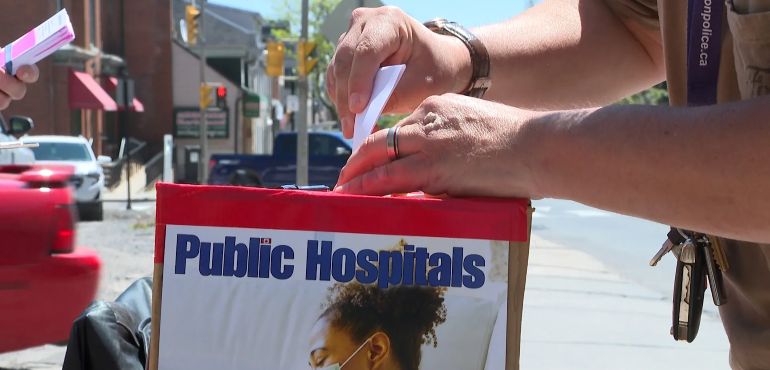Health care privatization in Ontario has become a major concern. In January 2023, Premier Doug Ford announced plans to privatize surgeries and diagnostic tests, moving these services from public hospitals to for-profit clinics. This has sparked fears about the future of public health care, with the Ontario Health Coalition (OHC) leading efforts to oppose the shift and protect public services.
Alternative Funding Solutions: Could Online Casino Taxes Fund Health Care?
Amid growing concerns over healthcare privatization and illegal extra billing, Ontario’s public healthcare system is under significant financial strain. Taxing the best online casinos could offer a viable solution, generating substantial revenue to support the system. Diversifying funding sources in this way, including taxing the best online casinos leading the charts in Canada, could help reduce pressure on public finances while maintaining the accessibility of health care services for all Ontarians.
This strategy not only creates a new source of money but also helps keep important health services available to everyone. By using the success of these popular platforms, Ontario could protect public health care without turning to privatization. Now, it’s important to take a closer look at what privatizing health care could mean.

Issue Overview
In January 2023, Premier Doug Ford unveiled a plan to privatize certain health care services, including surgeries and diagnostic tests. The rationale behind this decision was to reduce wait times and improve efficiency. However, this announcement has been met with significant opposition from health care professionals, patients, and advocacy groups.
Why Do Ontarians Concern?
Reduction in Staffing and Resources
One of the primary concerns is the potential reduction in staffing and resources in public hospitals. As services are transferred to private clinics, public hospitals may lose vital staff members, including nurses, doctors, and other health care professionals. This shift could exacerbate the existing staffing shortages and reduce the quality of care available in public facilities.
Increased Burden on Public Hospitals
Public hospitals, already struggling with limited resources, may face an increased burden as they are left to handle more complex and high-risk cases. For-profit clinics often focus on less complicated procedures, leaving public hospitals with the most challenging and resource-intensive patients.
Illegal Extra Billing by Private Clinics
Another major concern is the illegal extra-billing practices that have been reported in private clinics. Under the Canada Health Act, patients should not be charged for medically necessary procedures. However, there have been numerous instances where patients have been billed thousands of dollars for services that should be covered by OHIP. This practice undermines the principles of universal health care and places an unfair financial burden on patients.
Goals of the Campaign

The Ontario Health Coalition’s campaign aims to:
- Prevent the Privatization of Public Hospitals Services: Ensure that core health care services remain within the public system to guarantee equal access for all Ontarians.
- Ensure Adequate Funding and Support for Public Hospitals: Advocate for increased funding to allow public hospitals to utilize their existing resources effectively and reduce wait times without resorting to privatization.
- Raise Public Awareness and Mobilize Community Action: Inform the public about the risks of privatization and encourage community involvement to protect public health care.
Citizen-Run Referendum in 2023
To gauge public opinion on the privatization plan, the Ontario Health Coalition organized a citizen-run referendum (or public hospital vote) on May 26-27, 2023. Voting stations were set up across Ontario in markets, community centers, local businesses, and other accessible locations. Additionally, vote online option was available starting May 2, making it easier for more people to participate.
Key Results and Public Response
The Ontario referendum 2023 saw over 400,000 participants, with an overwhelming 99% voting against the privatization of public hospital services. This result highlights the strong opposition to privatization among Ontarians and underscores the need for the government to reconsider its plans.
Taking Action
May 30 Protest
Following the Ontario health care referendum, a protest was organized on May 30 to further oppose the privatization plan. This event aimed to demonstrate the public’s discontent and put pressure on the government to halt its privatization efforts.
Future Events
The Ontario Health Coalition continues to encourage participation in future protests and rallies. These events are crucial for maintaining momentum and showing the government that the public is united in its demand to keep health care services public.
Leaflet Distribution
The campaign’s goal is to distribute informational leaflets to two million Ontarians within the next two months. This effort involves leafletting at markets, fairs, workplaces, parks, and door-to-door. Volunteers are encouraged to update an online map to track where leaflets have been distributed, ensuring comprehensive coverage.
Online Voting and Voting Stations
The inclusion of online voting made participation more accessible for many Ontarians. This option was particularly beneficial for those unable to visit physical voting stations due to mobility issues, work commitments, or other constraints.
Voting stations were strategically placed across various regions, including Central East Ontario, Central Ontario, Eastern Ontario, the Greater Toronto Area, and others. This widespread availability ensured that as many people as possible could participate in the referendum.
How Ontarians Can Get Involved
Volunteer
Your time and effort can make a significant difference. Here’s how to help:
- Contact your local health coalition to volunteer for leaflet distribution.
- Assist in organizing community events and information sessions.
- Help staff voting stations in your area.
- To get started, email [email protected] for more information.
Donate
Financial support is crucial for sustaining this campaign. Donations help fund:
- Printing and distribution of informational materials.
- Organization of events and rallies.
- Maintenance of online resources and voting systems.
- Visit the Ontario Health Coalition website to make a contribution.
Stay Informed
Knowledge is power in this fight. To stay up-to-date:
- Visit the Ontario Health Coalition website regularly.
- Sign up for their newsletter.
- Follow their social media accounts for real-time updates.
Facts and Figures
Understanding the data behind this issue is crucial. Here are some key points:
- Ontario ranks last in Canada for public hospital funding per capita.
- The province has the lowest nurse-to-patient ratio in the country.
- Many public hospital operating rooms are underutilized due to lack of funding, not lack of physical space.
The consequences of privatization are not just theoretical. Take Lois Cooper’s story, for example. Referred to a private clinic for eye surgery, Lois ended up facing nearly $8,000 in extra charges – a practice that’s illegal under the Canada Health Act for medically necessary procedures. Her experience underscores the risks of a two-tier health care system where the ability to pay could determine access to care.
The Fight Is Still Going On
The results of the health care referendum in Ontario show that locals overwhelmingly support public health care. This aligns with national trends, where the majority of Canadians oppose health care privatization.
But the fight to preserve Ontario’s public health care system is ongoing and requires active citizen participation. By understanding the issues, sharing information, and taking part in community actions, Ontarians can play a crucial role in shaping the future of their health care system. Remember, a strong public health care system benefits everyone, ensuring that quality care is available based on need, not ability to pay.
